Your cart is currently empty!
Care Instructions
Bronze or Copper Finishes

HOW TO CARE FOR BRONZE OR COPPER FINISHES
Bronze or copper finished sculptures, add elegance to your décor and display your individual sense of style. Careful cleaning and maintenance of the patina grants long-term satisfaction.
CLEANING & MAINTENANCE
Dust off your sculpture regularly with a feather duster, a synthetic electrostatic duster, or a soft clean cloth or microfiber towel. If the object has developed a grimy film, more intense cleaning may be necessary. The best way to clean bronze or copper sculptures is with a mild soap and water.
Never use caustic chemicals containing ammonium, chlorine, solvents, or adhesive removers. Avoid paper towels, squeegees, steel wool and scouring pads
For cleaning a bronze or copper sculpture, add a few drops of a mild household soap in a bowl of water. Just add enough soap to make bubbles in the water because all you really need to do is loosen the dirt from the surface. Then dampen a clean cloth and gently wipe down the object. If the piece has a lot of nooks and crevices, a soft paint brush might be useful.
Once the sculpture is clean, rinse out the cloth and wipe down the object with clear water to remove the soap residue. Use the paint brush with clear water to clean areas that are hard to reach. Next, carefully dry the sculpture with a soft, dry cloth or microfiber towel.
Lighting
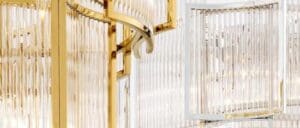
HOW TO CARE FOR LIGHTING WITH A METALLIC FINISH AND GLASS OR ACRYLIC
To maintain the beauty of your luxury lighting, we recommend the following simple guidelines. When cleaning a lamp, make sure you unplug the power cord first. Always make sure sprays or liquids can not get in the lamp fittings.
CLEANING & MAINTENANCE
For general maintenance, periodically dust off your lighting with a feather duster or a soft, clean cloth, preferably weekly.
METALLIC FINISHES
Use lukewarm water with a mild household detergent to clean metal finishes. Gently wipe the metallic surfaces, rods and parts with a soft, dampened cloth or chamois. Dry well with a clean, soft cloth. Never use cleaners with ammonia, bleach or hard chemicals and avoid paper towels or scouring pads.
GLASS
Never use abrasive materials for cleaning glass as they may cause scratches. Use appropriate glass cleaning solutions and a microfiber cloth. If you are using a chemical cleaner, take care not to spill it on any of the surrounding metallic finishes. After drying with a soft cloth, you can use a piece of crumpled newspaper to give the glass added shine and sparkle.
ACRYLIC
Avoid commercial household cleaners because the chemicals in these products can dull and craze the acrylic. The best way to care for acrylic surfaces, rods and parts, is to clean with lukewarm water and a bit of liquid soap. Rinse with clear water and dry well. Always use soft cloths for cleaning so as not to scratch the acrylic.
Glass, Mirrors and Acrylic

HOW TO CARE FOR GLASS, MIRRORS AND ACRYLIC
As beautiful as glass is, it’s also fragile and sensitive. In the right conditions, it can endure for hundreds of years, whether it’s clear glass, smoked glass, black glass or mirror glass.
CLEANING & MAINTENANCE
Since damage to the surface can easily detract from its original beauty, taking precautions is worthwhile. Do not place anything that has rough and sharp bases on a glass surface. Avoid scratches and water rings on glass table tops by using coasters and felt pads.
CLEAR GLASS, SMOKED GLASS & BLACK GLASS
Plain hot water makes the best everyday cleaner for glass surfaces and mirrors. Use appropriate glass cleaning solutions and a microfiber cloth for cleaning. If you are using a chemical cleaner, take care not to spill it on any of the surrounding finishes. Never use abrasive materials as they may cause scratches on the surface.
First, remove any dust and other non-sticky spills. Then spray water onto the surface with a spray bottle. Plain hot water works best since it leaves no streaks. Wipe the glass tabletop down with a microfiber cloth, to get rid of stains and dirt. Use straight vinegar to clean up spills or remove stubborn stains. Then use a clean, dry microfiber cloth to clean the vinegar away. As a final step, you can use a piece of crumpled newspaper to give your table an added sparkle. This removes any fluff and makes the glass shine.
After you give the glass surface or mirror a good cleaning, follow up once a week with a maintenance regimen and use regular water for the rest of the week.
MIRRORS AND MIRROR GLASS SURFACES
Avoid using paper towels for cleaning mirrors and mirror glass surfaces, as these can leave unsightly lint behind. Don’t use abrasives or cleaners containing ammonia or acid, since such products can destroy the silver backing and edges of your mirror.
ACRYLIC
While acrylic looks like glass, it is less breakable and about half the weight. When cleaning acrylic products, special care must be taken. Avoid commercial household cleaners because the chemicals in these products can dull and scratch the acrylic. The best way to care for your acrylic furniture is to clean with lukewarm water and a bit of liquid soap, rinse and dry. Always use a soft cloth so as not to scratch the acrylic surface.
Metal Finishes and Glass
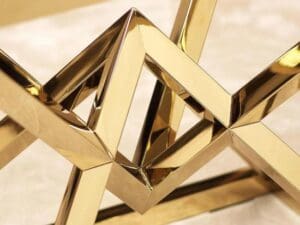
HOW TO CARE FOR METALLIC FINISHES AND GLASS
Metallic finishes and glass are popular in the design world since they can add an enhanced sense of glamor and style to any interior space. Careful cleaning and maintenance of metallic surfaces ensures that you will enjoy your furniture for years to come.
CLEANING & MAINTENANCE
Discover how to clean and maintain items comprising glass, silver-plating, polished stainless steel or metallic finishes. Do not place anything that has rough and sharp bases on a glass surface. Avoid scratches and water rings on tabletops by using coasters and felt pads.
SILVER-PLATED ITEMS, POLISHED STAINLESS STEEL AND METAL FINISHES
Dust off polished stainless steel and metal finishes regularly with a feather duster or soft clean cloth. Remove stubborn stains with tepid water or a mild household cleaner. Never use hot water, caustic chemicals or adhesive removers. Avoid paper towels, squeegees, etc.
Clean silver-plated items with a soft sponge with lukewarm water. Dip a clean cloth into silver polish and apply it in a thin film to the object. Gently rub the polish into the silver plating with a polishing cloth made for silver. Wash the item if it is to be used for serving food. Remove any excess silver polish with lukewarm water and a small amount of mild washing up liquid.
Clean polished stainless steel and metal finishes with diluted cleaner. Apply a small amount directly to a clean cloth and gently wipe the surface. If the finish is not altered or transferred to the cloth, continue with cleaning the rest of the product. Remove any cleaner residue with a clean cloth dampened with tepid water, then dry with a clean cloth. Do not let air dry.
Regularly polish metal finished parts with products that are made specifically for the care of polished metals, or with vinegar. For light polishing, dilute vinegar with water (1/2 cup of vinegar for every quart of water). Moisten a soft cloth in the diluted vinegar and polish the item. Use undiluted vinegar on items with heavy staining.
GLASS AND MIRRORS
Use appropriate glass cleaning solutions and a microfiber cloth for cleaning glass surfaces and mirrors. Don’t use abrasives or cleaners containing ammonia or acid, since such products can destroy the silver backing and edges of your mirror. If you are using a chemical cleaner, take care not to spill it on any of the surrounding finishes. Never use abrasive materials as they may cause scratches on the surface.
First remove any dust and other non-sticky spills. Then spray water onto the surface with a spray bottle. Plain hot water works best since it leaves no streaks. Wipe the glass surface or mirror down with a microfiber cloth. Use straight vinegar to clean up spills or remove stubborn stains. Dry with a clean microfiber cloth. As a final step, use a piece of crumpled newspaper for an added sparkle. This removes any fluff and makes the glass shine.
Furniture with Fabric Upholstery
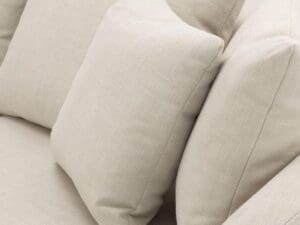
HOW TO CARE FOR FURNITURE WITH FABRIC UPHOLSTERY
Whether or not your upholstered furnishings are purely decorative or both functional and stylish, careful cleaning and maintenance of the fabric grants long term satisfaction.
To fully enjoy your fabric seating and ensure its longevity, please follow a few basic rules:
- Don’t place your seating near a fireplace that’s in use.
- Avoid exposure to excessive sunlight.
- Be careful with jeans that can transfer colour onto the fabric: this may be unfixable.
- Don’t expose your seating to scratches from pets or sharp objects (e.g. studs, buckles).
CLEANING & MAINTENANCE
Routine maintenance helps keep your upholstered furniture in perfect condition. Vacuum clean the upholstery regularly to keep the fabric in good shape and prevent dust, hair and crumbs from settling into the body of the furniture. Be careful with fringes and tassels: vacuum clean them only with low power.
Remove spills and other accidental stains as soon as possible, but never with harsh soaps or detergents. In the case of an old and dried-up stain, the first step is always vacuuming.
For stain removal use a specialised stain cleaner such as HG stain remover or a similar product. Follow the instructions on the packaging and always try the solution on an inconspicuous part of the upholstery before using it on a more noticeable portion.
To maintain the original softness and resilience of the cushions, hand fluff and reverse the cushions regularly.
Marble|Stone
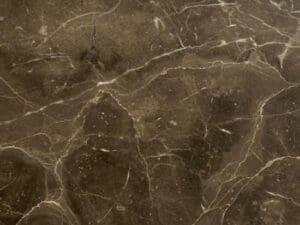
HOW TO CARE FOR MARBLE AND STONE
Marble is limestone that has metamorphosed and combined with natural elements. It is veined with a variety of colours and patterns. Since marble and stone are easily stained, etched, and dulled, it is important that you know how to take care of it.
There are a few basic rules for getting the most out of your marble and stone furniture and ensuring its longevity:
- Be careful of wet rings forming on the surface after watering flowers or plants.
- Place coasters or trivets under glasses and dishes to prevent the formation of ring marks.
- Never expose the furniture to sharp objects which can scratch the marble and stone.
- Never use vinegar on marble as its acid can cause the marble and stoneto corrode.
CLEANING & MAINTENANCE
Dust marble and stone surfaces once or twice per week with a soft cloth. Marble and stone stain very quickly, especially if liquids sit untouched on their surface. Immediately clean orange juice, coffee, wine, and other drinks (or food) with strong pigments and rinse with a clean, damp cloth. Never leave water on marble or stone surfaces as it can cause stains.
Clean as gently as possible, never using abrasive cleaners or dusting sprays. Wash marble and stone periodically with a cloth dampened with lukewarm water, and if necessary, some mild dishwashing liquid. Gently run the cloth over the surface, making a circular motion in the spots that need a little extra pressure. Remove the soap with another damp cloth and wipe the marble dry.
Use a chamois after cleaning to dry and shine your natural surface. Commercial marble and stone polishes also work well. If you choose a commercial polish, make sure it is specially designed for marble and stone use as certain chemicals can be harmful. Regularly apply marble and stone polish to maintain the luster of the stone.
Wood Veneer
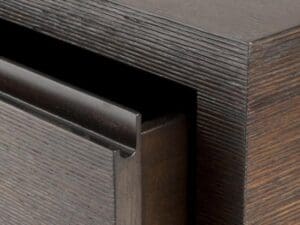
HOW TO CARE FOR WOOD VENEER
Veneer furniture is covered in a thin layer of real hardwood. Veneers are often used in high-end furniture pieces and can be more costly than solid wood. In the Mid 20th century it became especially popular in interiors when teak wood was often used for Danish design furniture
To fully enjoy your wood veneer furniture, please follow a few basic rules:
- Avoid exposure to direct sunlight and excessive heat or dampness.
- Be careful not to leave a wet ring on the surface after watering flowers or plants.
- Don’t expose the furniture to scratches from pets or sharp objects.
- Use coasters and place felt pads under lamp bases and accessories.
CLEANING & MAINTENANCE
Wood veneer requires gentle care to preserve the finish. Dust regularly and clean with a soft dry cloth.
Remove spills immediately as moisture can cause the veneer to peel off the surface. Prevent moisture from getting underneath the veneer by quickly and thoroughly cleaning up any spills.